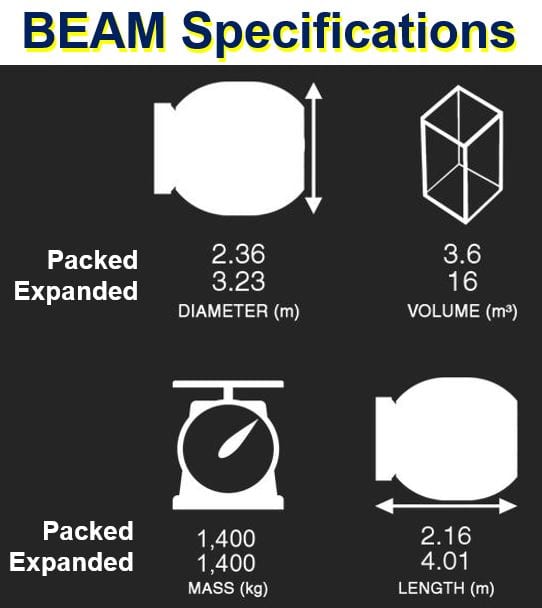We could soon have space rooms orbiting Earth – and perhaps one day on the Moon and even Mars – that instantly expand to become living areas for astronauts and private hotel rooms for wealthy cosmo-tourists. NASA will be testing a new technology over the next two years on the International Space Station.
The BEAM – Bigelow Expandable Activity Module – is an experimental programme developed by Bigelow Aerospace, an American space technology startup company based in Las Vegas, Nevada, USA, under a NASA contract.
The aim is to test and validate expandable habitat technology, and determine whether it can withstand the hostile environment of space and has potential for future usage in microgravity or other planets and moons.
 In 2012, NASA signed a $17.8 million contract with Bigelow Aerospace to develop the Bigelow Expandable Activity Module (BEAM). Over the next two years, it will be attached to the International Space Station and closely monitored to see whether it has future potential. (Image: http://bigelowaerospace.com)
In 2012, NASA signed a $17.8 million contract with Bigelow Aerospace to develop the Bigelow Expandable Activity Module (BEAM). Over the next two years, it will be attached to the International Space Station and closely monitored to see whether it has future potential. (Image: http://bigelowaerospace.com)
NASA will leverage the ISS (International Space Station) to test this intriguing technology for a 2-year demonstration period.
On 8th April, BEAM will be launched in the unpressurized aft trunk compartment of the Dragon spacecraft on its 8th resupply mission to the International Space Station – SpaceX CRS-8.
According to Bigelow Aerospace, the mission has the following objectives:
– Increase TRL (Technology Readiness Level) of expandable habitat technology.
– Demonstrate expandable habitat technology’s launch and deployment as well as packing and folding techniques.
– Determine whether BEAM effectively protects humans from space radiation.
– Demonstrate design performance, including mechanical & structural durability, long-term leak performance, temperature control, etc.
 According to NASA: “Expandable habitats, occasionally described as inflatable habitats, greatly decrease the amount of transport volume for future space missions. These “expandables” weigh less and take up less room on a rocket while allowing additional space for living and working. They also provide protection from solar and cosmic radiation, space debris, and other contaminants. Crews traveling to the moon, Mars, asteroids, or other destinations could use them as habitable structures.” (Image: http://bigelowaerospace.com)
According to NASA: “Expandable habitats, occasionally described as inflatable habitats, greatly decrease the amount of transport volume for future space missions. These “expandables” weigh less and take up less room on a rocket while allowing additional space for living and working. They also provide protection from solar and cosmic radiation, space debris, and other contaminants. Crews traveling to the moon, Mars, asteroids, or other destinations could use them as habitable structures.” (Image: http://bigelowaerospace.com)
The 4 stages of the BEAM mission:
1. LAUNCH: in a packed configuration, the BEAM will be launched in the trunk of the Dragon spacecraft.
2. BERTHING: the Canada Arm removes BEAM from the Dragon spacecraft. It will berth the module to the Tranquility node of the International Space Station.
3. DEPLOYMENT: ISS crew members will initiate an automated deployment sequence, allowing BEAM to passively expand to its full volume.
4. TESTING: the BEAM will be monitored for radiation protection, micro-meteoroid/debris impact detections, pressure and temperature. ISS crew members will periodically enter the BEAM (four times per year) to record data and carry out inspections of the module.
The probability of penetration is very low, NASA says. If it did happen, the BEAM would slowly leak – it would not burst. It is designed this way to preclude any damage to the rest of ISS.
When the two-year trial is completed, BEAM will be released from ISS to burn up on reentry into Earth’s atmosphere.
About Bigelow Aerospace
Bigelow Aerospace was founded by Robert Bigelow in 1998. Mr. Bigelow owns the hotel chain Budget Suites of America, which caters to budget travelers needing to stay for an extended period.
His aerospace start up is largely funded by the profit he gained through his ownership of Budget Suites of America.
 Robert Bigelow. Will he be remembered one day as the father of the space hotel industry? (Image: twitter.com/roberttbigelow)
Robert Bigelow. Will he be remembered one day as the father of the space hotel industry? (Image: twitter.com/roberttbigelow)
By 2013, Mr. Bigelow had invested about $250 million in Bigelow Aerospace. He said he is willing to increase his investment to $500 million.
The company’s initial aim is to create a modular set of space habitats for creating or expanding space stations.
Related article: “Inflatable living space BEAM successfully attached to International Space Station”
Video – Space X set to launch inflatable space hotels
Bigelow’s inflatable space habitat will be launched in a Space X rocket on 8th April and attached to the International Space Station. The BEAM, a 565 cubit-foot habitat, will stay on the ISS for two years of testing. NASA believes the future of space accommodation is in expandable habitats.
